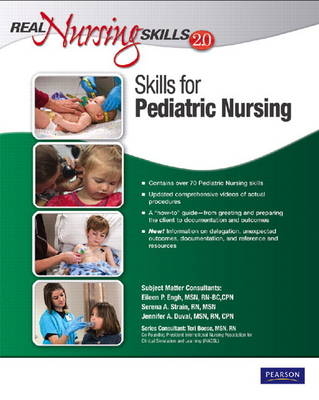
Real Nursing Skills 2.0
Pearson (Hersteller)
978-0-13-700946-6 (ISBN)
- Titel ist leider vergriffen;
keine Neuauflage - Artikel merken
GROUPING ONE: Assessment Pediatric Assessment and Considerations Vital Signs and Measurements for an Infant Vital Signs and Measurements for a Child Variation: Thermometer reading in an infant Variation: Oral Route temperature in a child Variation: Axillary Route temperature in a child Placement of Electrodes for a 12 lead Electrocardiogram Using the Glasgow Coma Scale Providing Cast Care and Neurovascular Assessment Using a Snellen E or Picture Chart Hearing Acuity Screening: Tympanometry & Pure Tone Audiometry Selected Pediatric Pain Scales GROUPING TWO: Positioning and Restraint Positioning/Preparation of a Child for Intravenous Access/Injection Positioning a Child for Lumbar Puncture Positioning for an Otoscopic Examination: Child and Infant Applying Elbow Restraints to a child Applying a Mummy Restraint on a child Variation: Applying a Papoose Restraint GROUPING THREE: Specimen Collection Blood Cultures Blood Glucose Meter Performing Venipuncture & Accessing a Peripheral Vein Collecting a Catheter Specimen Obtaining a Sample for Wound Culture/Wound Irrigation Obtaining a Sample for Throat Culture Collecting Respiratory Secretions from a Child Collecting Respiratory Secretions from an Intubated patient GROUPING FOUR: Medication Administration Administering an Intramuscular Injection Administering a Subcutaneous Injection Ear Irrigation Eye Irrigation Administering an Opthalmic Medication Administering an Otic Medication Administering a Nasal Medication Administering an Oral Medication Administer Nebulizer Aerosol therapy Using a Metered Dose Inhaler Metered Dose Inhaler VARIATION: Diskus Topical Medication: Burn Wound Care Administering a Rectal Medication GROUPING FIVE: Parenteral Medication Administration Starting an Intravenous Infusion Administering an Intravenous Push Medication Infusing Medication: Saline Lock Administering an Intravenous Medication: Burritrol with an infant Administering Blood or Blood Products Administering Client-Controlled Analgesia (PCA) Pumps Accessing a Central Venous Catheter Site Implanted Ports Conscious Sedation Monitoring GROUPING SIX: Nasogastric and Orogastric Tube Interventions Inserting an Orogastric Tube Administering a Gavage/Tube feeding Inserting and Removing a Nasogastric Tube GROUPING SEVEN: Urinary Elimination Interventions Intake and Output Measurement for Infants Applying a Urine Collection Bag Performing a Urinary Catheterization GROUPING EIGHT: Cardio/Respiratory Interventions Oxygen Delivery Systems: Blow-by Oxygen Delivery Systems: Nasal Cannula Oxygen Delivery Systems: Face Mask Pulse Oximetry Variation: Portable Pulse oximeter Using a Cardiorespiratory Monitor Using a Peak Expiratory Flow Meter Using the Incentive Spirometer Oropharyngeal Airway Insertion Assisting Nasopharyngeal Airway Insertion Tracheostomy General Guidelines and Care Bag-Valve-Mask Ventilation Removing a Foreign Body Airway Obstruction: Concious Child and Unconscious Child between ages 1 and 8 Performing Chest Physiotherapy/Postural Drainage GROUPING NINE: Airway Clearance Interventions Tracheostomy Suctioning Endotracheal Tube Suctioning Nasal/Oral Suctioning Using a bulb syringe Using a Yankauer (tonsil tip catheter) Suctioning a Conscious (Awake and Alert) Child Suctioning a Child with Decreased Level of Consciousness GROUPING TEN: Wound Care Changing the Dressing for an Infant with an Ostomy Changing an Ostomy Pouch for an Infant or Child Changing Central Venous Catheter Site Dressing
| Erscheint lt. Verlag | 15.8.2011 |
|---|---|
| Zusatzinfo | sd., col. |
| Sprache | englisch |
| Maße | 167 x 251 mm |
| Gewicht | 120 g |
| Themenwelt | Medizin / Pharmazie ► Pflege ► Kinderkrankenpflege |
| ISBN-10 | 0-13-700946-1 / 0137009461 |
| ISBN-13 | 978-0-13-700946-6 / 9780137009466 |
| Zustand | Neuware |
| Haben Sie eine Frage zum Produkt? |